Energy security push! India plans 10% mandatory LNG extra reserve; aims cost-effective buffer for price, supply shocks

India is planning to make it mandatory for all liquefied natural gas (LNG) import terminals to build an additional 10% storage capacity that the government can access during supply or price disruptions. According to a draft proposal by the oil ministry, this change will amend the registration rules for LNG terminals under the Petroleum and Natural Gas Regulatory Board (PNGRB), reported ET.“An entity seeking registration to operate an LNG terminal shall also have a credible plan for maintaining the storage capacity for LNG,” the draft states. It further specifies that “this storage capacity shall be 10% higher than the requirement for day-to-day operations of the terminal” and will be made available to the central government “as and when desired.”
Plan aims to create cost-effective emergency reserves
Officials said the proposal seeks to establish a strategic gas reserve system without building new underground storage, which has been deemed too costly. India had previously explored strategic natural gas storage similar to its petroleum reserves, but the plan did not materialise due to high costs.The idea is to use existing LNG import terminals as a built-in buffer for emergencies, ensuring cost-effective and quicker deployment compared to developing storage in depleted gas fields or rock caverns.As per ET, an official said that storing additional gas at terminals is cheaper and logistically simpler than constructing dedicated facilities. India currently imports nearly half of its natural gas requirements, making such a model strategically important for energy security.
Financial and operational criteria for new projects
The draft proposal also sets out strict eligibility norms for companies seeking to operate LNG terminals. Firms or their promoters must have a net worth of Rs 1,500 crore for the past three financial years and a track record of completing infrastructure projects worth over Rs 1,000 crore, or hydrocarbon projects exceeding Rs 600 crore, within the last five years.India has eight operational LNG terminals with a combined capacity of 52.7 million tonnes per annum (mtpa), but most operate below 40% utilisation. Industry executives said the draft is unclear on whether the additional storage must remain filled or could function as a common-carrier facility accessible to other users — an issue likely to need regulatory clarification from PNGRB.They added that, if treated as a shared facility, PNGRB may need to regulate how this capacity is allocated among users.The government had previously tasked ONGC, Oil India, and GAIL with studying the feasibility of setting up natural gas storage in depleted fields, but the idea stalled due to prohibitive costs. The new framework, if approved, would shift that responsibility to industry players, marking a significant shift in India’s energy security strategy.






